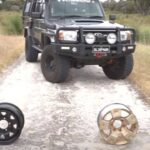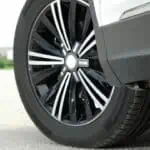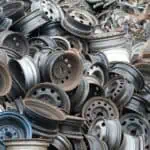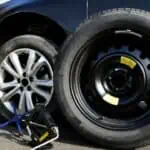Are you looking for What Size Rim Do I Need for a 35X12.5 Tire? There are a few things to consider when selecting the right size rim for your 35×12.5 tires.
First, you need to know the bolt pattern of your vehicle. Most vehicles have a 5 or 6 lug bolt pattern.
Second, you need to know the offset of your rims. The offset is the distance from the hub mounting surface to the centerline of the wheel. A positive offset means the hub mounting surface is closer to the outside edge of the wheel, while a negative offset means it’s closer to the inside edge.
Third, you need to know the width of your rims. Rim widths can range from 6 inches all the way up to 15 inches or more. And finally, you need to decide if you want a chrome or black finish on your rims.
You May Like
For those of you who are looking to buy a new set of rims for your 35×12.5 tires, the answer is that you will need a 17 inch rim. This size rim will provide the best support for your tires and help to improve your gas mileage no doubt.
What Size Rim Goes on a 35 Inch Tire?
There’s no definitive answer to this question as it depends on the make and model of your vehicle. However, we can give you some general guidelines. Most 35 inch tires will fit on a 17 inch rim.
Some may even fit on a 16 inch rim, but this is less common. If you’re unsure about what size rim to get for your 35 inch tires, it’s best to consult with a professional or the manufacturer of your tires.
You May Also Like
What Size Rim Fits a 35X12 50R20?
There are a few things to consider when determining what size rim fits a 35X12 50R20 tire. First, you need to know the width of the tire. The width is 12 inches.
Next, you need to know the diameter of the tire. The diameter is 20 inches. Finally, you need to know the bolt pattern of the wheel.
The bolt pattern is 5 on 4.5 inches. With this information, you can determine that the appropriate rim size for a 35X12 50R20 tire is 15×8 inches.
How Do I Know What Size Rim I Need?
Before you can purchase the correct size rim for your vehicle, you’ll need to take some measurements. To start, you’ll need to know the width of your current tires. You can find this information on the sidewall of your tires.
Once you have the width, you can multiply it by 1.5 to get the minimum width rim that will fit your tires. For example, if your tire has a width of 225mm, you would need a rim that is at least 337mm wide (225 x 1.5 = 337). In addition to width, you’ll also need to know the bolt pattern of your vehicle.
Yes, the bolt pattern is the number of bolts on your wheel and the distance between them. This information can be found in your owner’s manual or online. With both the width and bolt pattern, you can then purchase the correct size rim for your vehicle!

Can I Put 35 Tires on 20 Rims?
No, you cannot put 35 tires on 20 rims. Rims are sized according to the width of the tire they are designed to accommodate. A 20 rim is too narrow to safely support a 35 tire.
The tread of the tire would overhang the edge of the rim, which could result in the tire coming off the rim while you are driving. This could cause a serious accident.
What Size Rim for 33 X 12.5 Tire
There are a few different ways that you can figure out what size rim for 33 x 12.5 tires. The first way is to look at the sidewall of the tire and find the recommended wheel width. This width will be listed in millimeters (mm).
For example, if the sidewall of your tire says “Recommended Wheel Width: 8-10”, then you would want to get rims that are 8-10 inches wide.
Another way to figure out what size rims you need is by using a tire calculator. There are a few different ones available online, but they all work in basically the same way.
You just enter in your tire size and it will tell you what width rims you need.
Finally, you can always just ask someone at a tire or auto shop. They should be able to help you figure out what size rims you need for your 33 x 12.5 tires.
Also Read: What Tires Fit 17x9 Rims? In-Depth Info.Cheapest Rim Size for Tires
There are a few things to consider when determining the cheapest rim size for tires.
The first is the width of the tire. Wider tires will typically cost more than narrower ones.
The second is the diameter of the rim. Larger rims will also generally be more expensive than smaller ones.
The end, the type of material used for the rim can affect cost.
For example, aluminum rims may be cheaper than those made from steel or titanium. In general, wider and larger rims will be more expensive than narrower and smaller ones. However, there are some exceptions to this rule depending on the specific circumstances.
For your Info, if you need a very wide tire for off-road use, it may be cheaper to buy a wider rim and have it specially made for your application than it would be to purchase a narrow one and then have to replace it later down the road when your needs change.
Ultimately, it is important to weigh all of your options before making a decision so that you can get the best value for your money.
What Size Rims for 35 Inch Tires
Yes, when it comes to choosing the right size rims for your 35 inch tires, there are a few things you need to take into consideration. First, you need to know the width of your tire. The wider the tire, the wider the rim should be.
If you have a narrow tire, you can get away with a narrower rim. Second, you need to think about the offset of the rim. This is how far the hub of the wheel sticks out from the center of the wheel.
A higher offset means that the hub is closer to the edge of the wheel, while a lower offset means that it’s closer to the center. You’ll want to choose an offset that’s appropriate for your vehicle and driving style. Finally, you need to consider what type of terrain you’ll be driving on.
If you’re planning on doing a lot of off-roading, then you’ll want a rim that’s built for that kind of abuse. But if you’re just sticking to paved roads, then any good quality rim will do just fine. When in doubt, always consult with a professional before making your final decision.
What Size is a 35 Inch Tire on a 18 Inch Rim
In general, a 35 inch tire on an 18 inch rim is going to be too big. The reason for this is that the sidewall of the tire will be very tall, and the overall diameter of the tire will be too large.
This can cause problems with clearance, handling, and even safety. It’s always best to consult with your local tire dealer or automotive specialist to see what size tires are recommended for your specific vehicle.
35 Inch Tire Size for 17 Inch Rim
Tire size is a confusing topic, and trying to determine the right size for your vehicle can be even more so. When it comes to 17 inch rims, there are a few different options available in terms of tire size. A 35 inch tire size is one option that you may be considering.
Here’s what you need to know about this particular size. First, it’s important to understand that there is no standardization when it comes to tire sizes. That means that the same size designation can mean different things from one manufacturer to the next.
So, while a 35 inch tire size may be an option for your 17 inch rims, it’s important to make sure that it will work with your specific tires. The best way to do this is by checking with the manufacturer or with a professional at a tire shop.
Another thing to keep in mind is that even if a 35 inch tire size will fit on your 17 inch rims, it doesn’t mean that it’s the best option.
In general, wider tires provide better traction and handling than narrower ones. So, if you’re looking for the best performance possible, you may want to consider going with a wider tire. Just keep in mind that you’ll also need to adjust your suspension accordingly if you go this route.
Finally, it’s worth noting that while a 35 inch tire size may be an option for your 17 inch rims, they aren’t always the best choice aesthetically speaking. If you’re worried about how they’ll look on your car, ask around or look at pictures online before making any final decisions.
All things considered, choosing the right tire size for your 17 inch rims isn’t an easy task.
But by doing some research and talking to experts, you should be able to find an option that works well for both your needs and wants.
Custom Offsets Match Up: 35×12.5 on 17×8.5
35 Inch Tires on 15 Inch Rims
35 inch tires are a popular choice for many truck and SUV owners. They offer a wider stance, which can improve stability and handling, while also providing a more aggressive look. However, before you make the switch to 35 inch tires, there are a few things you need to know.
For starters, 35 inch tires will put additional stress on your suspension and steering components. This means that you may need to upgrade some of these parts before making the switch. Additionally, your speedometer will no longer be accurate once you install 35 inch tires.
This is because the larger circumference of the tire will cause it to travel further than what is indicated on the speedometer. As such, you’ll need to keep an eye on your actual speed when driving.
Finally, you should be aware that 35 inch tires can negatively affect your fuel economy.
This is due to the increased rolling resistance of the larger tires. So, if fuel economy is important to you, consider sticking with smaller tires.
Overall, 35 inch tires can offer some benefits for truck and SUV owners.
Just be sure to do your research beforehand and be prepared for some potential downsides.
Conclusion of What Size Rim Do I Need for a 35X12.5 Tire
If you’re looking to buy a new set of tires, you may be wondering what size rims you need for a 35×12.5 tire. The answer depends on a few factors, but we can help you figure it out.
First, it’s important to know that there are two different types of 35×12.5 tires – load range E and load range D. Load range E tires are designed for heavier vehicles, like trucks and SUVs, while load range D tires are meant for lighter vehicles, like cars and vans.
So, if you’re putting 35×12.5 tires on a truck or SUV, you’ll need to get wheels that are at least 8 inches wide with a 5-inch backspace. For lighter vehicles, 7-inch wide wheels with a 4-inch backspace should be sufficient. Of course, your mileage may vary depending on the specific vehicle and tire combination.



















